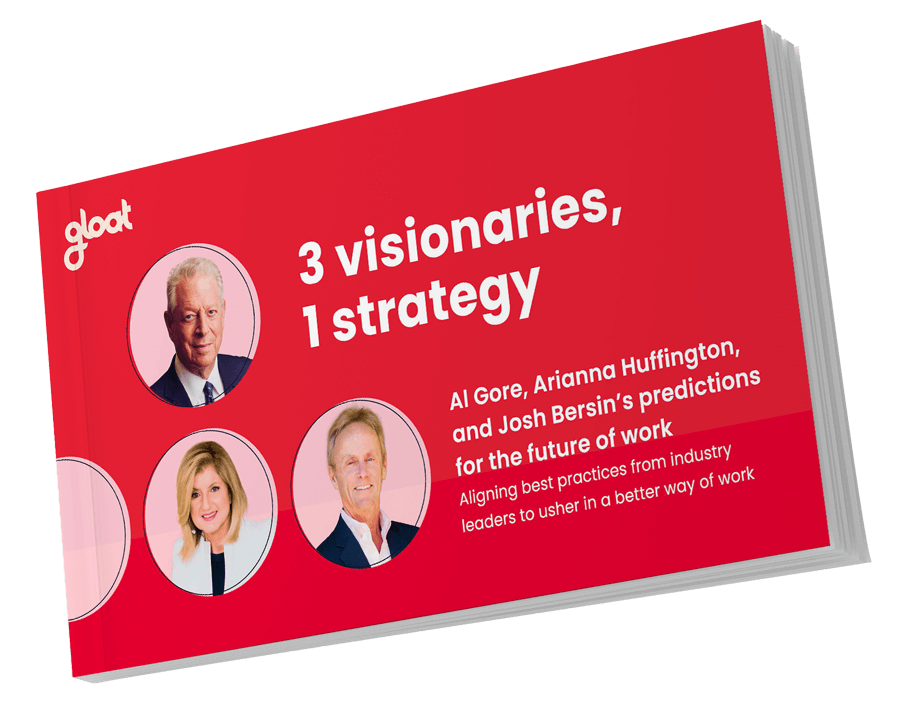6 trends defining the future of talent acquisition
Exploring how talent acquisition strategies are changing in the new world of work

Decades ago, talent acquisition processes were straightforward. Since skill needs and market demands were relatively predictable and most organizations relied on strict job hierarchies, companies turned to external hiring whenever there was a vacancy that needed to be filled.
However, it’s not nearly as simple in the new world of work. Amidst ongoing economic instability and ever-widening knowledge gaps, companies must be more strategic about how they acquire talent. Rather than bringing new employees into their organizations by default, HR teams must decide when existing employees can be upskilled or reskilled, when talent from another team or department can be borrowed, and when recruiting externally is truly the best option.
To add another layer of complexity to the equation, companies are increasingly embracing skills-based operating models in favor of traditional job-centric hierarchies. As a result of these major talent management shifts, HR and talent acquisition teams must keep their fingers on the pulse to stay updated on the latest talent sourcing trends so they can capitalize on them for their organization’s benefit.
6 emerging trends for talent acquisition
There are a handful of mindset shifts and emerging technological innovations that are coming together to reshape talent acquisition processes, including:
#1. AI and machine learning
AI and machine learning are taking the business world by storm in 2023—and there’s no sign of a slowdown. While nine in ten employees at higher levels in their organizations are already experimenting with generative AI, there’s only a small subset of workers who have the skills and expertise needed to fully make use of these innovations. 62% of full-time employees believe they don’t have the skills to effectively and safely use generative AI.
Beyond generative tools, leaders are concerned that their workforces are lacking capabilities that will become critical as AI-powered systems become more mainstream and new use cases emerge. Nearly one in two HR managers anticipate skill gaps as their workforce adopts AI.
Rather than letting AI-related knowledge gaps widen, talent acquisition leaders must work with HR to identify the capabilities that will be most crucial for harnessing AI-powered innovations across the organization. Once companies have an idea of the skills they will need to prioritize, talent acquisition teams can make strategic decisions about which roles they will need to hire externally for. Skills intelligence tools like Gloat’s Skills Foundation arm leaders with key workforce planning insights, including uncovering where knowledge gaps lie and spotlighting trending skills.
#2. Automation in talent acquisition
In addition to bridging the skill gaps associated with AI’s rapid proliferation, talent acquisition leaders must also consider how they can use AI-powered tools to automate their own internal processes. Many components of the recruitment journey can be streamlined with these innovations, including screening resumes and setting up and scheduling interviews.
AI-powered technology can help source, screen, sort, and rank candidates to create a pipeline of qualified talent who have skills and expertise that align with the competencies needed for high-priority roles. Talent acquisition leaders can then compare these prospective employees with internal candidates they’ve identified through their talent marketplace, which uses AI to match employees to open opportunities within their organization based on their skills and career goals.
#3. Remote work and virtual hiring
Leaders can no longer consider hybrid and remote working an experiment or an alternative to occasionally resort to. In the aftermath of COVID-19 and the Great Resignation, greater flexibility around when and where work is done is something most employees have come to expect. In fact, if an organization were to return to a fully on-site arrangement, it would risk losing up to 39% of its workforce.
Consequently, executives must continue to adapt their operating models and internal practices to match employee expectations and business needs. As skill gaps widen, HR teams can’t risk alienating candidates by limiting their autonomy and flexibility. To avoid this, talent acquisition and HR should align on a hybrid or remote working policy that works for their organization and ensure these standards are communicated both internally and externally.
#4. The importance of internal mobility
Rather than relying on perks and benefits that only boost employee morale in the short term, leaders are recognizing that the key to retaining talent with in-demand skills is providing them with internal career growth opportunities. Two-thirds of employees acknowledge that they would quit their jobs if internal mobility wasn’t offered. The chance to explore new development opportunities is particularly important to younger workers, with three out of four Gen Z employees asserting that they’re eager to learn and practice new skills.
Talent acquisition leaders must ensure that both internal and external candidates are aware of their organization’s commitment to helping employees grow within their company. Internal talent marketplaces that match employees to opportunities that align with their skills and goals send a strong message that your organization is dedicated to growing its people.
#5. Diversity and inclusion
While most organizations are eager to become more equitable, many leaders struggle to determine which tools and initiatives will actually move the needle. Nearly 50% of CEOs count building an inclusive workforce as high on their list of challenges. Ultimately it requires more than a subtle strategy shift; companies must fundamentally reimagine their work culture and democratize career development to empower employees from all walks of life.
Talent acquisition teams can play a pivotal role in their organization’s DEI efforts by ensuring sourcing, recruitment, and hiring processes aren’t swayed by potentially bias-inducing decision factors. Instead of relying on subjective criteria like geographic proximity or professional networks when evaluating candidates, inclusive organizations take an objective approach based on employees’ skills and experiences. Many of these companies harness talent marketplaces to ensure internal mobility is determined by peoples’ competencies and ambitions, in turn empowering all employees to grow their careers with their organization.
#6. Data-driven decision-making
Every component of business strategy must be data-driven by default in the new world of work—and talent acquisition is no exception. Now that talent landscapes are more complex and external hiring is no longer the default solution for filling vacancies, talent acquisition leaders must harness data to make informed workforce planning decisions.
No organization can afford to spend money acquiring external talent when someone within their company has the skills they’re looking for. Rather than overspending on hiring and recruiting, HR and talent acquisition teams are turning to skills infrastructure tools like Gloat’s Skills Foundation to understand the capabilities their workforce has and uncover how to best tap into them. These systems enable talent acquisition managers to make informed decisions about when they want to hire for a role and when internal talent can be upskilled, reskilled, or borrowed to fill it.
How to adapt to the future of talent acquisition
After years of relying on relatively static talent sourcing strategies, talent acquisition teams may struggle to adapt to the trends that are reshaping HR priorities in the new world of work. To help organizations upgrade their talent acquisition processes, many leaders are turning to new technology, including skills intelligence tools and talent marketplaces. The former gives executives insights into the skills their workforce has and the capabilities their people need to inform strategic workforce planning decisions, while the latter is crucial for promoting internal mobility across the organization and empowering employees to step into new roles and fill existing vacancies.
To learn more about the tools and strategies that leaders must embrace to overcome the new world of work’s talent challenges, check out our guide 3 visionaries, 1 strategy, which features predictions from Arianna Huffington, Al Gore, and Josh Bersin.





